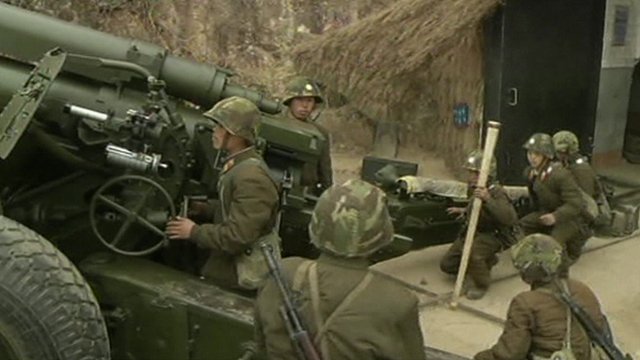South Korea has deployed two warships with missile-defence systems, reports say, a day after the North apparently moved a missile to its east coast.

Military officials told South Korean media the two warships would be deployed on the east and west coasts.
Seoul has played down the North’s missile move, saying it may be for a test rather than a hostile act.
In recent weeks, the North has ramped up its rhetoric and made specific threats to target US territory.
One of the targets named by Pyongyang was the Pacific island of Guam, which hosts a US military base.
On Thursday, the US confirmed it would deploy a missile-defence system to Guam in response to the threats.
“The moves that we have been making are designed to ensure and to reassure the American people and our allies that we can defend the United States,” said state department spokeswoman Victoria Nuland.
South Korea’s foreign minister told MPs on Thursday that the North had moved a missile to the east coast, which is the location for previous military tests.
Unconfirmed reports on Friday said the North had moved two missiles, and had loaded them on to launchers.
The BBC’s John Sudworth in Seoul says the move will certainly be interpreted as upping the ante yet again.
The missiles are thought to be mid-range Musudans, which are untested in flight but are thought to have the capacity to reach as far as Guam.
The South Korean news agency Yonhap said that two warships equipped with Aegis defence systems would monitor the situation.
“If the North fires off a missile, we will trace its trajectory,” Yonhap quoted an official as saying.
Meanwhile, Russian diplomats said the North’s foreign ministry had asked them to consider evacuating their Pyongyang embassy.
The diplomats said they had no immediate plan to evacuate, stressing there were no outward signs of tension in Pyongyang.
It was not clear what had prompted the request.
‘Turn down volume’
Despite North Korea’s belligerent rhetoric, it has not taken direct military action since 2010, when it shelled a South Korean island and killed four people.
But in recent weeks it has threatened nuclear strikes and attacks on the US and South Korea.
It has announced a formal declaration of war on the South, and pledged to reopen a mothballed nuclear reactor in defiance of UN Security Council resolutions.
Many of North Korea’s angry statements have cited the annual military exercises between US and South Korean forces as provocation.
The US flew nuclear-capable B-2 and B-52 bombers over the South as part of the drill, and has since deployed warships with missile-defence systems to the region.
North Korea’s official media say the US is surrounding the peninsula with a nuclear threat from land, sea and air.
Reports in US media quoting unnamed Pentagon officials suggest Washington is now questioning whether some of its actions may have contributed to the tension.
CNN quoted a Pentagon official as saying the US would now try to “turn the volume down” on its rhetoric.
In recent weeks, the North has shut down an emergency military hotline between Seoul and Pyongyang and stopped South Koreans from working at a joint industrial complex in the North.
The Kaesong complex, one of the last remaining symbols of co-operation between the neighbours, is staffed mainly by North Koreans but funded and managed by South Korean firms.





